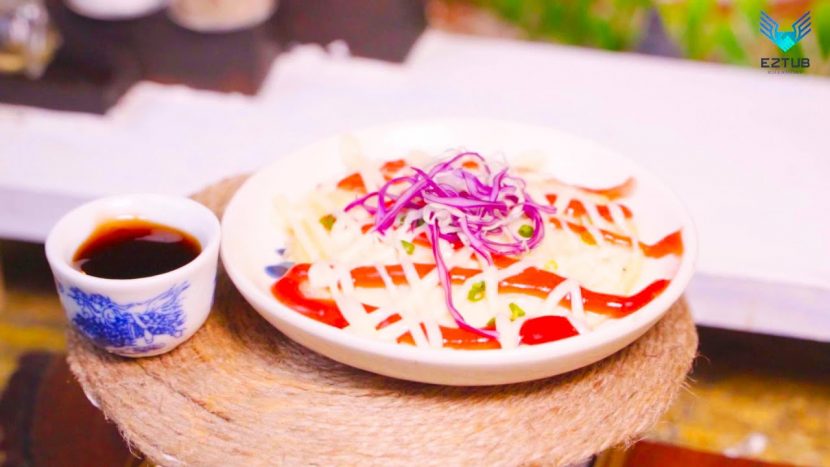Learn how to make Japanese savory pancakes – Okonomiyaki. This is a very popular Japanese-style pancake that is usually topped with a variety of ingredients. In this video, we’ll teach you how to make Japanese savory pancakes that are topped with a variety of ingredients, including seafood. Okonomiyaki isn’t difficult to make, and it’s very versatile. It’s an excellent choice for a party or get-together. It’s also a good dish to experiment with. Mix and match the ingredients to create your own unique flavor combination.

Okonomiyaki are Japanese savoury pancakes packed with flavour and SO easy to make! Ready in less than 30 minutes, this ‘as you like it‘ pancake recipe is sure to be the new family favourite.
Why We Love This
This is one of our favourite (and most cooked) Japanese recipes ever from our blog. That’s because when it comes to delicious, healthy and quick recipes, nothing beats Japanese style savoury pancakes!
The batter is super simple to prepare and cook, with a mouth-watering mix of toppings including Japanese okonomiyaki sauce (similar to bbq sauce) and Kewpie mayonnaise.
It’s such a versatile recipe – literally make it as you like it! Go for the traditional ingredients listed below, add others to suit your tastes, or use up leftover veggies from the fridge.
What is Okonomiyaki?
As a quick translation, okonomi (as you like it) + yaki (grilled) stands for a simple pancake batter made from flour, eggs and stock flavoured water (usually dashi), filled with cabbage and other tasty ingredients like pork, shrimp or corn.
You’ll find this classic Japanese street food dish at markets, festivals and specialty okonomiyaki restaurants where it’s cooked on large hot plates in the middle of the table. It’s also a popular meal Japanese families will cook at home, usually tweaking the recipe to suit their own tastes, methods or to use up ingredients they already have on hand.
Where We Learned This Recipe
Out of all of Japan’s delicious street food dishes (piping hot takoyaki, yakisoba noodles, hand-rolled sushi and onigiri rice balls) this is the dish that takes us right back to Osaka (the city that’s our beloved second home).
We first tried okonomiyaki with our Osaka-mum Rieko and her friend Noriko. They took us to their favourite restaurant in Osaka, where the piping hot pancakes were cooked on a teppan hot plate right in front of us. One taste and we were hooked! We’ve since been back to Japan and tried it at a few different places around the city and on our adventures across the country.
Each region does it a little differently, with different batter and topping ingredients. Our favourite version is Kansai/Osaka style Okonomiyaki because that’s where we first tried it, but we also enjoyed Hiroshima-style Okonomiyaki made with soba noodles.
What You’ll Need
See the recipe card below for the full ingredients and quantities. Here’s a little more info about the key ingredients you’ll need:
For the pancake base:
- Pork / Bacon – While Osaka/Kansai-style okonomiyaki is usually topped with thin strips of pork belly, at home we’ll substitute with bacon slices for convenience. If you’re after thinly sliced pork, shabu shabu hot pot style, you can usually find these at Asian grocers in the freezer section.
- Cabbage – We usually use Asian cabbage (known as wombok or napa cabbage), but frequently make it with savoy or cannonball cabbage and they work just fine.
- Flour – The batter is made with a mix of all purpose flour and cornstarch to give it a little extra crispiness.
- Dashi Powder – We usually use dashi powder instead of dashi stock as it’s much quicker to use, especially when you only need such a small amount to flavour the batter. If you have the time, you can also make your own dashi stock at home.
For the toppings:
- Okonomiyaki Sauce – This is the key to the classic okonomiyaki flavour. You can make your own homemade okonomiyaki sauce with a few simple sauces you probably already have on hand, buy it online (look for the “Otafuku” brand), or from Asian grocers. It’s similar(ish) to yakisoba sauce or tonkatsu sauce, so feel free to use either if you already have one on hand.
- Kewpie Mayonnaise – It’s best to use Japanese Kewpie mayonnaise because it has a unique flavour compared to regular mayonnaise. You’ll sometimes find it in well stocked supermarkets (head to the International aisle), online or from Asian grocers, or make your own Japanese Kewpie mayonnaise at home. You can also find more Kewpie recipe ideas here.
- Dried Seaweed Flakes – Known as aonori in Japanese, this is finely chopped seaweed that adds a beautiful colour and subtle flavour to the pancakes. Substitute with nori seaweed if you need to (tear it or slice it up into small flakes).
- Dried Bonito Flakes – Known as katsuobushi in Japanese, this is dried, smoked bonito fish that is finely shaved into flakes. The umami flavour is out of this world, and not as ‘fishy’ as it smells. We also love watching the flakes curl up and dance when topped over piping hot okonomiyaki! If you’re not a fan, just leave it out.
- Pickled Red Ginger (Optional) – Also known as beni shoga, it adds a hint of tangy flavour and crunch. It’s also a popular topping for takoyaki. Super easy to make your own red pickled ginger at home! It’s becoming more common at regular supermarkets, otherwise buy from an Asian grocer or online. If you don’t have any or can’t source it, just leave it out.
- Japanese 7 Spice (Optional) – Also known as shichimi togarashi, this seasoning is as common as salt and pepper in Japanese cuisine, usually paired with aonori. You can buy it online, find it at Asian grocers or even make it at home like we did.
How to make Japanese ‘As You Like It’ Pancakes:
- Fry the bacon until cooked through and crispy, then set aside to cool. No need to use oil here, as the bacon will release its own oil as you cook it.
- To make the batter, combine the eggs and dashi powder dissolved in the warm water in a small mixing bowl and beat gently. In a separate large mixing bowl add your flour and cornflour, then pour over with the egg and dashi stock mixture. Stir and combine until smooth.
- Next, add the shredded cabbage, half of the green onion slices, cooked bacon and corn into the batter mixture. Mix until all the dry ingredients are evenly coated (but don’t overmix, we want to keep that cabbage nice and fluffy). There shouldn’t be much excess batter liquid at the bottom – if there is, just add a little more chopped cabbage and mix through gently.
- Scoop out the mixture onto a large frying pan over medium heat. We like aiming for a circle shape about 10 cm / 4 inches wide. Cook each pancake for a few mins per side, until lightly browned on both sides.
- Transfer your freshly cooked pancakes to serving plates, then top with drizzles of kewpie mayonnaise and okonomiyaki sauce. For even better tasting okonomiyaki, top with sprinklings of dried seaweed flakes, bonito flakes and a few slices of green onion to taste. You can also optionally top with the pickled ginger and Japanese 7 spice here.
Tips:
- Thinly Sliced Protein is Key – Whether you use pork, bacon or a different protein, always make sure it’s thinly sliced so it will cook through quickly.
- For Cool Visual Effect – add a layer of bacon or pork on the the pan before topping with the batter. When you flip the pancake, the meat will be visible on top.
- Pre-heat your Pan – This will help ‘seal’ the bottom of your pancake quickly and hold the round shape. Use your spatula to scrape any rogue batter back to the pancake.
- Medium Heat – Medium heat works best to cook the pancakes as it allows the inside of the pancake to steam and cook through the middle, without burning the outsides.















